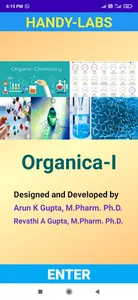App design for 12th and UG students & educationalist academicians specifically who are interested in Pharmacy & Chemistry practical’s.
In this app we will learn, how we carried out the Organic Chemistry-I practical in laboratory with safety. This app also give general information about safety and precautions, laboratory glassware’s and equipment’s with pictorial representation. This application guides the students to perform the Organic Chemistry-I practical in a simple and easy manner.
All the experiments commonly performed especially by the Pharmacy students as wells as Chemistry graduates. HandyLabs Organica-I includes qualitative analysis of organic compounds, derivative preparations, 3D–plastic molecular models representation and laboratory techniques of organic chemistry. Each experiment contains Object, Principle, Procedure Observation and Result in a very illustrative manner. Each part of the experiment are clearly explain with diagram. The speciality of the application is demonstration video included for easy understanding of learners.
This app version 1.0 certainly based on the response it will be converted in more practical aspect with user friendly. Experiments involving
1. Systematic qualitative analysis of unknown organic compounds includes following parameters
Preliminary test: Color, odour, aliphatic/aromatic compounds, saturation and unsaturation, etc.
Detection of elements like Nitrogen, Sulphur and Halogen by Lassaigne’s test
Solubility test
Functional group test like Phenols, Amides/ Urea, Carbohydrates, Amines, Carboxylic acids, Aldehydes and Ketones, Alcohols, Esters, Aromatic and Halogenated Hydrocarbons, Nitro compounds and Anilides.
Melting point/Boiling point of organic compounds
Identification of the unknown compound from the literature using melting point/ boiling point.
Preparation of the derivatives and confirmation of the unknown compound by melting point/ boiling point.
2. Systematic analysis of organic compounds
a. Benzoic acid
b. -Naphthol
c. Cinnamic acid
d. Salicylic acid
e. Resorcinol
f. Thiourea
g. Urea
h. Sucrose
i. D-glucose
j. Fructose
k. Maltose
l. Diphenylamine
3. Preparation of suitable solid derivatives from organic compounds
a. Amide derivative of benzoic acid
b. 3,5-dinitrobenzoate derivative of ethanol
c. 2,4-dinitrophenylhydrazone derivative of acetone
d. Picrate derivative of naphthalene
e. Osazone analogs of fructose
f. N-substitute phthalimide analogs of aniline
4. Construction of molecular models
In this app we will learn, how we carried out the Organic Chemistry-I practical in laboratory with safety. This app also give general information about safety and precautions, laboratory glassware’s and equipment’s with pictorial representation. This application guides the students to perform the Organic Chemistry-I practical in a simple and easy manner.
All the experiments commonly performed especially by the Pharmacy students as wells as Chemistry graduates. HandyLabs Organica-I includes qualitative analysis of organic compounds, derivative preparations, 3D–plastic molecular models representation and laboratory techniques of organic chemistry. Each experiment contains Object, Principle, Procedure Observation and Result in a very illustrative manner. Each part of the experiment are clearly explain with diagram. The speciality of the application is demonstration video included for easy understanding of learners.
This app version 1.0 certainly based on the response it will be converted in more practical aspect with user friendly. Experiments involving
1. Systematic qualitative analysis of unknown organic compounds includes following parameters
Preliminary test: Color, odour, aliphatic/aromatic compounds, saturation and unsaturation, etc.
Detection of elements like Nitrogen, Sulphur and Halogen by Lassaigne’s test
Solubility test
Functional group test like Phenols, Amides/ Urea, Carbohydrates, Amines, Carboxylic acids, Aldehydes and Ketones, Alcohols, Esters, Aromatic and Halogenated Hydrocarbons, Nitro compounds and Anilides.
Melting point/Boiling point of organic compounds
Identification of the unknown compound from the literature using melting point/ boiling point.
Preparation of the derivatives and confirmation of the unknown compound by melting point/ boiling point.
2. Systematic analysis of organic compounds
a. Benzoic acid
b. -Naphthol
c. Cinnamic acid
d. Salicylic acid
e. Resorcinol
f. Thiourea
g. Urea
h. Sucrose
i. D-glucose
j. Fructose
k. Maltose
l. Diphenylamine
3. Preparation of suitable solid derivatives from organic compounds
a. Amide derivative of benzoic acid
b. 3,5-dinitrobenzoate derivative of ethanol
c. 2,4-dinitrophenylhydrazone derivative of acetone
d. Picrate derivative of naphthalene
e. Osazone analogs of fructose
f. N-substitute phthalimide analogs of aniline
4. Construction of molecular models
Show More























